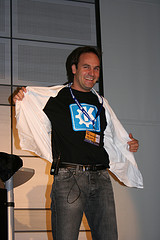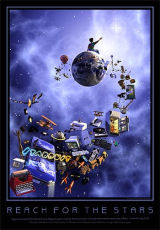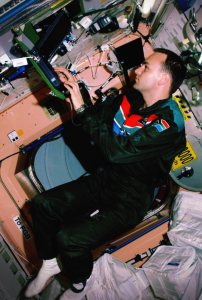Over at Linux World there’s a piece from Mark Shuttleworth about how he stays connected whilst traveling. We learn how he manages to work on Ubuntu … almost anywhere.
It’s revealed that Mark Shuttleworth uses Mozilla Thunderbird as his normal email client and for answering email off-line. Thunderbird is an email reader from the same people who brought us the legendary Firefox, it’s just as useful too.
In places without net access
Using off-line email reading and replying means that you do not have to remain hooked-up permanently to the internet. You’re free to download the email from your service provider, then to write replies without being connected. Any emails that you’ve written will get sent when you next find you can locate some internet access.
One problem with being off-line is, what to do you come across a web-link you’d like to view, but don’t have any immediate internet connection. Mark goes on to explain to us about he uses Firefox bookmarks to work-around not having a connection at that moment, allowing the pages to be viewed all together a bit later.
One glitch in [my] routine is when people send me email with a URL in it. I am often offline when I get to the email, so it can be frustrating because I can’t then see the document […] when I’m online, I can trivially get T-bird to show me all the mails that need online attention, and open all the relevant pages in tabs in a new Firefox window.
The History of Thinkpads and sabdfl
Mark Shuttleworth seems to be a bit of a laptop “road-warrior” in the wildest sense. Searching around the First African in Space site, we can find lots of interesting things about the week-long trip he spent in space. It turns out that during the visit he managed to smuggle, not just one, but two, laptops up to the International Space Station in the Russian Soyuz rocket.
At conferences, Mark Shuttleworth is often seen traveling with one a sleek black laptop. This is an X-series IBM ThinkPad, which you can spot about 1 minute from the start of this video on YouTube. The video slot appeared on Channel 4 in the UK and features an interview and introduction to Ubuntu and about Free Software.
Many of the Ubuntu developers use models of the IBM ThinkPad range, or the more shiny Apple Powerbooks. As a result of the high-concentration amongst the core developers, both of these types of computer are the first to get top-marks for full Ubuntu compatibility by the Laptop Testing Team.
Generally it seems that when Mark wants advice about something, he asks those most likely to know to answer. Often that could be several people with a variety of views! At one of the first Ubuntu conferences, before Ubuntu even had a name, Mark asked around the room for suggestions for a new laptop. Back came various shouts of “ThinkPad! ThinkPad!“—and this is exactly the laptop that Mark has been sporting ever since.

As we found out, after 2003 conference in Oxford (UK), the sabdfl turned up with a new, IBM Thinkpad X40—since that time, the laptop appears to have traveled almost as much as its owner.
During this years LinuxTag in Germany Mark stripped off, and it wasn’t just his secret love of KDE that got revealed. If the well cared-for IBM X40 notebook had a personality, it was soon to have been in for a shock. There was another new kid on the block, a somewhat newer Core Duo Lenovo Thinkpad X60 could be spotted peeking out of his bag.
The Thinkpad X60 hardware was so brand-new that there were still a few issues to be resolved with full Ubuntu support—as can be expected from buying bleeding-edge hardware to run Linux on. But, when the Ubuntu boss has a new laptop, Ubuntu starts working on that machine even faster than normally! Not wanting to drop the trusty IBM X40 until the new laptop had proved itself, Mark has frequently been spotted carrying two laptops around. “Just in case”.
We’ll have to wait another couple of years to see what the X60 gets replaced by! But, you don’t have to wait that long if you’re interested in what happened to the two IBM ThinkPads that found their way up the space station. There’s some information about the testing performed on arrival and we find out that whilst on-orbit they were designated TP1 and TP2.
Laptops in Space
Each Thinkpad A22p that travelled up to the space station was a PIII 1Ghz machines running MS Windows XP, though Mark has since said that he “wished he’d taken Debian instead”. You’ll be pleased to know that while on the space station, the laptops were running some Free Software on top. One of the tasks on board was the generation of a huge picture entitled Reach for the Stars. Pieces of the design came from many contributing individuals around the world with the result being produced on-orbit by the POV-Ray 3D render as the station flew overhead. The resulting poster-sized picture is spectacular, as is the story told of its creation, which can be read about in the Making of… section .
After the week-long stay at the space-station, the laptops stayed onboard, rather than returning to Earth with the crew. As Mark Shuttleworth noted, the two laptops were several times more powerful than the existing 166Mhz Thinkpads allowed on the station at that time:
The Russians gave me permission based on the fact that there were no obviously new plastics or materials that might cause a problem, and the battery technology was known to them… Certifying a new laptop through ESA or NASA would have cost a fortune, but the Russians took the view that it wasn’t mission critical for them, there were no major risks, and if it worked then they would have two new laptops on orbit that were much faster than anything else up there.
On return from space, Mark cradled a pair of IBM Microdrives in his space-suit, containing all the data from the week of experiments on-board the station. Later on, after many months the Russian and American space-experts brought the laptops back to Earth. An inspection into the condition of the laptops after having spent so long in space was undertaken, with the conclusion that the electronics hadn’t suffered adversely from radiation exposure.
According the American Radio Relay League, before the return of the laptops, one of the A22p machines even found use as an Amateur Radio packet-router to be used by HAM radio enthusiasts around the world. This laptop ‘experiment’ with modern hardware has subsequently paved the path for allowing more modern hardware to be used in space.

Phoning home
The International Space Station (ISS) is in an orbit where it doesn’t just go around the Earth, but appears to bob up and down as it circles the Earth. At one point the station could be over Australia and then 45 minutes later passing over Europe. Later on, the ISS could be speeding over South Africa before heading up to pass over Russia, China and Japan. All this jumping around certainly complicates making contact between the space station and the those on the ground.
Through out the day, the types of connections available to the cosmonauts and astronauts constantly change depending on whether the Earth is “in the way”, or not. When there exists a visible connection to one of NASA’s satellites, a high-speed Ku-band transmitter operating at 12-14Ghz provides the station with audio, video and data links. For the crew on-board, this also means a 2Mb/s internet connection to NASA in Houston!
One day mission control noticed that the crew morale had improved, with those on-board being much happier. It turned out that one of the crews had quietly installed a Cisco VoIP (Voice over IP) client on to an ISS laptop. By using the IP connection and then dialing out of the NASA telephone exchange, this allowed the crew to call their friends and family by telephone.
The only downside of using the VoIP connection from space turns out to be the delay, or ‘lag’ . Because the connection is bounced off another satellite in geosynchronous orbit, the signal takes 6-7seconds to reach the space station and return to the ground-station. Sometimes when Mark Shuttleworth used the system to call another person back on Earth, that person would just hang up because the line “sounded silent”. Apparently his solution was to start saying “Don’t hang-up, it’s Mark, calling from space” over and over whilst the telephone still sounded like it was ringing!
We noticed that Mark has transferred a copy of the story to his blog. It’s just waiting for comments or questions! Would you hang up if somebody was calling you from space?
